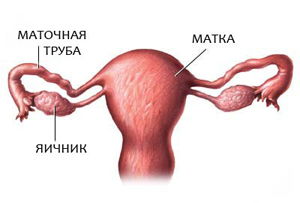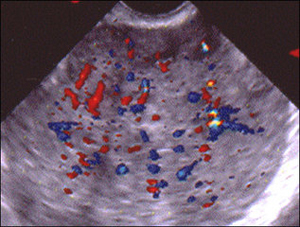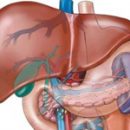Modern views on the risk factors for the occurrence of the disease
Sporadic cancer of ovarian
Content
In the literature it is often indicated that in Western Europe and the United States ovarian cancer ranks third in frequency among malignant tumors of the female sex tract. In general, this is the fifth frequency and for the causes of mortality from all malignant neoplasms of cancer after breast cancer, colorectal cancer, lung and stomach cancer. However, in terms of mortality rates during the first year from the moment of detection of the disease and in terms of late detection of the disease of the ovarian cancer, certainly leads.
On modern views on the risk factors for the occurrence of the disease of sporadic cancer of the ovarian, we will talk to Maxim Markovich Vysotsky, the leading doctor-obstetrician-gynecologist of the highest category, D.M.N., Professor, a member of the National Association of Gynecologists of Endoscopists of Russia.
Corner.: Maxim Mark Ovich, as far as this disease is Grozny? What factors affect its occurrence? Who enters the risk group?
Ovich, as far as this disease is Grozny? What factors affect its occurrence? Who enters the risk group?
Maxim Markovich: The average age of establishing a diagnosis of sporadic cancer of the ovarian is 58 years old. The frequency of the disease increases to 75 years, after which the decline begins.
It is assumed that a number of reproductive factors seriously affect the frequency of cancer of the ovarian. The most significant protective factor is the frequency of dead pregnancies. There is evidence that the risk of disease is reduced with each docking pregnancy by 13-19%. Generally speaking, the risk decreases with each pregnancy, donated or interrupted, just during pregnancy, completed childbirth and breastfeeding, risk reduction more. However, a number of scientists dealing with this problem indicates an increase in ovarian cancer risk if the age of first pregnancy was less than 19 years, compared with the first pregnancy after 25 years. Additional risk factors consider the onset of the first menstruation (menarche) to 11 years, later entry into the postmenopause period (after 55 years), the late age of the first pregnancy (after 35 years). Generally accepted is the idea of infertility as an additional factor for the risk of ovarian cancer. Women with inexplicable infertility have a much greater risk to get sick cancer. The cessation of ovulation and normalization of the hormonal background leads to a decrease in the frequency of ovarian cancer. These are classic epidemiological data for women receiving monophase hormonal contraception. It is known that the peaks of the incidence of ovarian neoplasms fall on the age of hypergrongadotropinemia 58 – 75 years (hypergronadotropinemia - a pathological increase in the content of follicularity and luteinizing hormones), normalization of the hormonal background leads to a decrease in the frequency of the occurrence of ovarian tumors.
Using oral contraceptives for more than 5 years half reduces the frequency of ovarian cancer. Fundamental leadership of WHO for tumors of female genitals and breasts (WHO Classification of Tumours, 2003) emphasizes the possibility of reducing the risk of ovarian cancer when using oral contraception and a large number of birth.
The use of substitution hormone therapy in postmenopausus does not allow to obtain unambiguous data on the effect on the risk of ovarian cancer. In general, replacement hormone therapy does not increase the risk.
Corner.: Does this disease affect the occurrence of this disease, food?
Maxim Markovich: Pretty sharp discussions are underway on the role of dietary risk factors in the genesis of ovarian cancer. Classical data on the high frequency of ovarian cancer in countries with a western style of life and food is difficult to challenge. For example, epidemiologists are trying to find an explanation to an increase in the frequency of ovarian cancer in Japanese, who have moved to the US. Stormy spores still causes the role of dairy products, coffee, vegetable fiber, vitamin A and selenium.
Many obsobiological links of the mechanism of the emergence and development of diseases of neuroendocrine tumors have changed significantly in the process of human evolutionary development. For example, for modern women, Menarche is typical of modern women in comparison with residents, a smaller number of childbirth, a later entry into the postmenopause period, frequent and early breastfeeding. Using the example of primitive tribes, it is shown that where it has to produce food independently, the age of the onset of the woman is equal to approximately 16 years (there is probably the slow increase in body weight and fatty tissue), and the average age of the first birth of 19.3 years. The interval between the beginning of the menarche and the first kinds for women of primitive tribes of hunters-collectors is 3.5 years, and for a modern woman – 14 years old. Perhaps most of the events of the subsequent reproductive life are pretty early. The duration of lactation in women primitive and their similar groups is 3-4 years due to the absence of liquid food for the decoration of children. Long lactation provides the necessary interval between birth. In industrialized countries, the age of menarche – 12.5-13 years old. In the United States, the number of women first give birth over the age of 30 years, increased 4 times, and the age of menopause rose from 48.5 to 51.5 years, t.E. Entry in the postmenopause period has shifted to age more than 52 years. It is an early menarh, late menopause, unrealized reproductive function and limitation of lactation make up a group of reproductive risk factors of tumors. All these factors in one way or another are associated with hypergronadotropinemia and «Continuous ovulation».
Studies of scientists show , that high growth and increase in body weight is associated with an increased risk of ovarian tumors, especially those who were annoying that, according to the authors of these studies, is due to damage to the cover epithelial epitheliality as a result of continuous ovulation. The results of these studies have shown the connection of the growth and mass of the body with the risk of ovarian cancer. Including 1.1 million women aged in 14 to 74 years from 1963 to 1999, the authors revealed that the increased risk of ovarian cancer has women who have overweight in childhood or young age. In senior women, such regularity failed to identify. It was possible to establish a link between the growth and risk of ovarian cancer, especially endometrioid, for women under 60 years.
, that high growth and increase in body weight is associated with an increased risk of ovarian tumors, especially those who were annoying that, according to the authors of these studies, is due to damage to the cover epithelial epitheliality as a result of continuous ovulation. The results of these studies have shown the connection of the growth and mass of the body with the risk of ovarian cancer. Including 1.1 million women aged in 14 to 74 years from 1963 to 1999, the authors revealed that the increased risk of ovarian cancer has women who have overweight in childhood or young age. In senior women, such regularity failed to identify. It was possible to establish a link between the growth and risk of ovarian cancer, especially endometrioid, for women under 60 years.
Features of nutrition, physical activity, as well as, perhaps, some social habits, such as coffee abuse, belong to risk risk factors. Research relating to physical activity is not so much and their data is also contradictory. The protective role of ordinary physical activity to reduce the frequency of cancer of the ovarian proves. Under ordinary physical activity it is understood by the ordinary load, excluding and reduced weight, and reduce the conversion of hormones in fatty tissue.
From nutritional factors, according to many researchers, the most significant is fat content. So, in Japan, where, on average, the share of fat is less than 19% of the total calorie content of the diet, the incidence of ovarian cancer is one of the lowest in the world, and, for example, in the US, the amount of fat in food often exceeds 45%, and the problem of ovarian cancer is far from His permission. Researchers pay attention to the fact that the low fat content in the young age is especially important. It has also been established that in the diet of people of the Paleolithic fat, fat accounted for up to 20-25% of energy revenues. It is believed that the consumption of fiber-rich foods helps to reduce the frequency of reproductive tumors. On the one hand, the resorption of estrogen in the intestine is reduced, but on the other hand, such a diet contains the predecessors of lignin, which, after processing by intestinal bacteria, are absorbed as weak estrogens. These substances together with phytoestrogen stimulate the synthesis of sex steroids of the binding globulin (PSSU) in the liver, reducing the level of free steroid hormones.
Corner.: Maxim Markovich, and nicotine and alcohol may affect the occurrence of ovarian tumors?
Maxim Markovich: The consumption of alcohol and tobacocco on the frequency of malignant tumors is discussed in the literature. And some scientists showed an increase in the frequency of ovarian cancer in smokers, however, for alcohol there were no such patterns. Assessing the role of active and passive smoking as the risk factors for ovarian cancer, researchers came to paradoxical results. The reduced risk of ovarian cancer was observed in non-smoke, but susceptible to the so-called «Passive smoking», Throwing smoking and smoking. In this case, the protective effect was observed in moderately and highly smokers. The authors suggested that some mechanisms that destroy carcinogens could be responsible for these effects.
Consequently, in the mechanism of the emergence and development of sporadic forms of ovarian neoplasms, it is necessary to pay hypergronadotropinemia, continuous ovulation, reproductive and food behavior issues, starting from early childhood.
Corner.: Thank you, Maxim Markovich for such a detailed and interesting story.
Cancer Ice. Today, this diagnosis is not a sentence, but the signal to the immediate beginning of treatment. Important diagnosis is important. The earlier the diagnosis is made, the higher the chance of a successful outcome of treatment. But, the main thing, as always, remains relevant today, and will continue to be relevant – Prevention! These are clinicalization, regular examinations of the gynecologist (at least 1 time in 6 months) and, of course, a healthy lifestyle. And the lifestyle should be healthy not when age changes in the body and related different disease begin, and from early childhood. To do not fight with bad habits, and not have them.
If we were not able to do with you at one time, let's have our daughters who still have the whole life ahead, to educate the culture of a healthy lifestyle and good habits: proper nutrition, maintaining an excellent physical form, refusal of smoking and alcohol abuse, regular medical examinations. After all, we want them to be healthy and happy, and happiness without health does not happen!
Vysotsky Maxim Markovich,
Lead Acoucher Gynecologist
highest category, d.M.N., Professor,
Member of the National Association









